Compressor SUZUKI SWIFT 2006 2.G Service Repair Manual
[x] Cancel search | Manufacturer: SUZUKI, Model Year: 2006, Model line: SWIFT, Model: SUZUKI SWIFT 2006 2.GPages: 1496, PDF Size: 34.44 MB
Page 969 of 1496
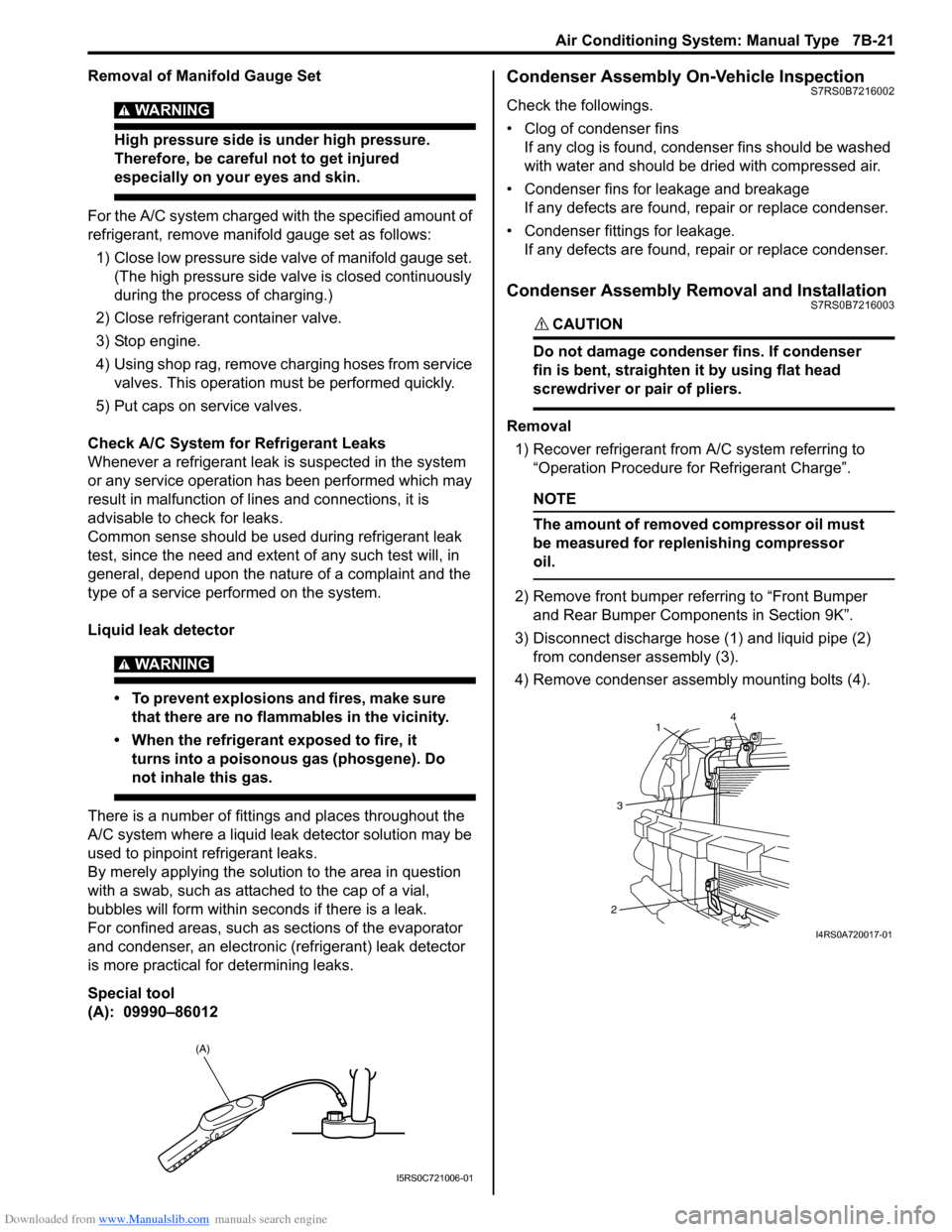
Downloaded from www.Manualslib.com manuals search engine Air Conditioning System: Manual Type 7B-21
Removal of Manifold Gauge Set
WARNING!
High pressure side is under high pressure.
Therefore, be careful not to get injured
especially on your eyes and skin.
For the A/C system charged with the specified amount of
refrigerant, remove manifold gauge set as follows:
1) Close low pressure side valve of manifold gauge set. (The high pressure side valve is closed continuously
during the process of charging.)
2) Close refrigerant container valve.
3) Stop engine.
4) Using shop rag, remove charging hoses from service valves. This operation must be performed quickly.
5) Put caps on service valves.
Check A/C System for Refrigerant Leaks
Whenever a refrigerant leak is suspected in the system
or any service operation has been performed which may
result in malfunction of lines and connections, it is
advisable to check for leaks.
Common sense should be used during refrigerant leak
test, since the need and extent of any such test will, in
general, depend upon the nature of a complaint and the
type of a service performed on the system.
Liquid leak detector
WARNING!
тАв To prevent explosions and fires, make sure that there are no flammables in the vicinity.
тАв When the refrigerant exposed to fire, it turns into a poisonous gas (phosgene). Do
not inhale this gas.
There is a number of fittings and places throughout the
A/C system where a liquid leak detector solution may be
used to pinpoint refrigerant leaks.
By merely applying the solution to the area in question
with a swab, such as attached to the cap of a vial,
bubbles will form within seconds if there is a leak.
For confined areas, such as sections of the evaporator
and condenser, an electronic (refrigerant) leak detector
is more practical fo r determining leaks.
Special tool
(A): 09990тАУ86012
Condenser Assembly On-Vehicle InspectionS7RS0B7216002
Check the followings.
тАв Clog of condenser fins If any clog is found, cond enser fins should be washed
with water and should be dried with compressed air.
тАв Condenser fins for leakage and breakage If any defects are found, repair or replace condenser.
тАв Condenser fittings for leakage. If any defects are found, repair or replace condenser.
Condenser Assembly Removal and InstallationS7RS0B7216003
CAUTION!
Do not damage condenser fins. If condenser
fin is bent, straighten it by using flat head
screwdriver or pair of pliers.
Removal
1) Recover refrigerant from A/C system referring to тАЬOperation Procedure for Refrigerant ChargeтАЭ.
NOTE
The amount of removed compressor oil must
be measured for replenishing compressor
oil.
2) Remove front bumper referring to тАЬFront Bumper and Rear Bumper Components in Section 9KтАЭ.
3) Disconnect discharge hose (1) and liquid pipe (2) from condenser assembly (3).
4) Remove condenser assembly mounting bolts (4).
(A)
I5RS0C721006-01
4
1
3
2
I4RS0A720017-01
Page 970 of 1496
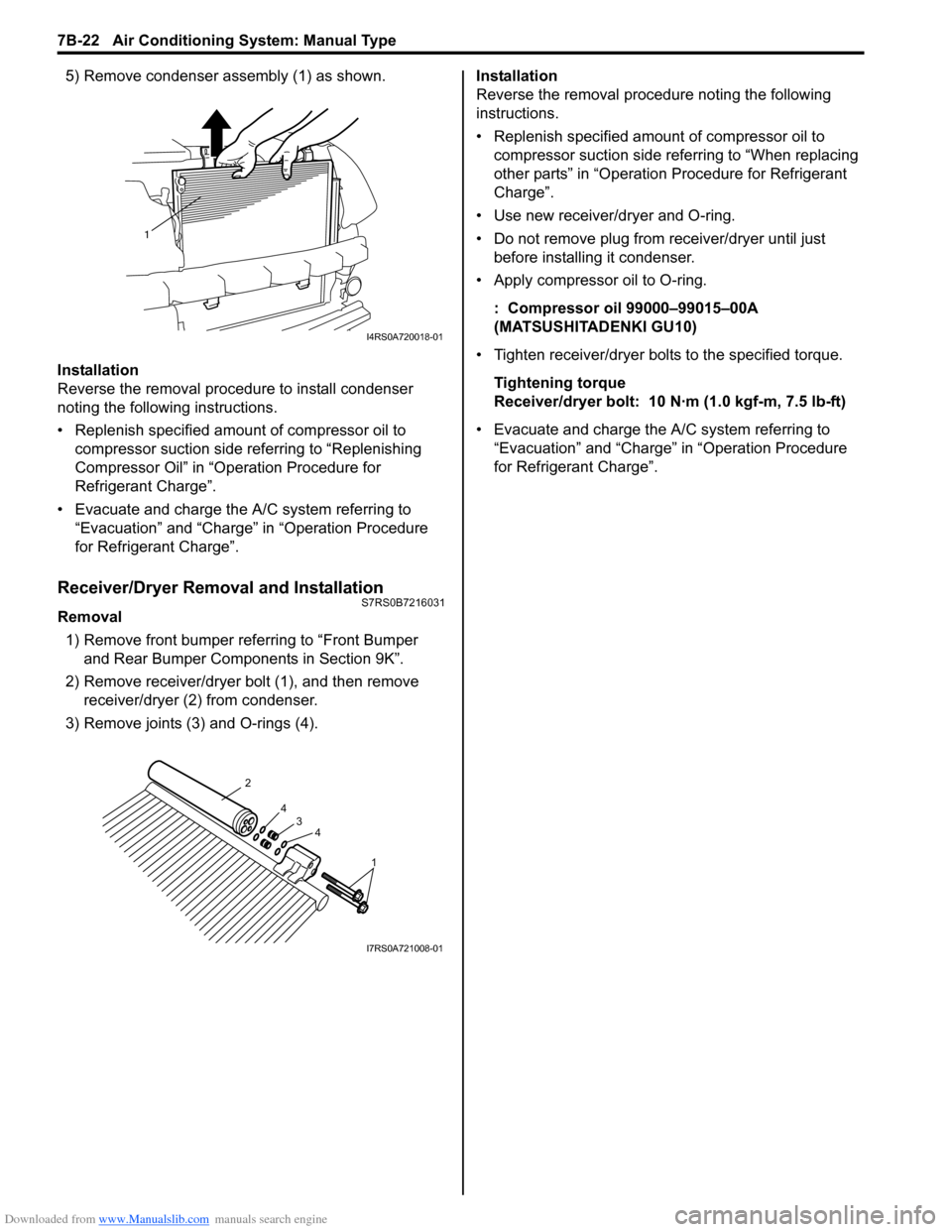
Downloaded from www.Manualslib.com manuals search engine 7B-22 Air Conditioning System: Manual Type
5) Remove condenser assembly (1) as shown.
Installation
Reverse the removal procedure to install condenser
noting the following instructions.
тАв Replenish specified amount of compressor oil to compressor suction side referring to тАЬReplenishing
Compressor OilтАЭ in тАЬOperation Procedure for
Refrigerant ChargeтАЭ.
тАв Evacuate and charge the A/C system referring to тАЬEvacuationтАЭ and тАЬChargeтАЭ in тАЬOperation Procedure
for Refrigerant ChargeтАЭ.
Receiver/Dryer Removal and InstallationS7RS0B7216031
Removal
1) Remove front bumper referring to тАЬFront Bumper and Rear Bumper Components in Section 9KтАЭ.
2) Remove receiver/dryer bolt (1), and then remove receiver/dryer (2) from condenser.
3) Remove joints (3) and O-rings (4). Installation
Reverse the removal procedure noting the following
instructions.
тАв Replenish specified amount of compressor oil to
compressor suction side referring to тАЬWhen replacing
other partsтАЭ in тАЬOperation Procedure for Refrigerant
ChargeтАЭ.
тАв Use new receiver/dryer and O-ring.
тАв Do not remove plug from receiver/dryer until just before installin g it condenser.
тАв Apply compressor oil to O-ring.
: Compressor oil 99000тАУ99015тАУ00A
(MATSUSHITADENKI GU10)
тАв Tighten receiver/dryer bolts to the specified torque. Tightening torque
Receiver/dryer bolt: 10 N┬╖ m (1.0 kgf-m, 7.5 lb-ft)
тАв Evacuate and charge the A/C system referring to тАЬEvacuationтАЭ and тАЬChargeтАЭ in тАЬOperation Procedure
for Refrigerant ChargeтАЭ.
1
I4RS0A720018-01
1
4
4
3
2
I7RS0A721008-01
Page 972 of 1496
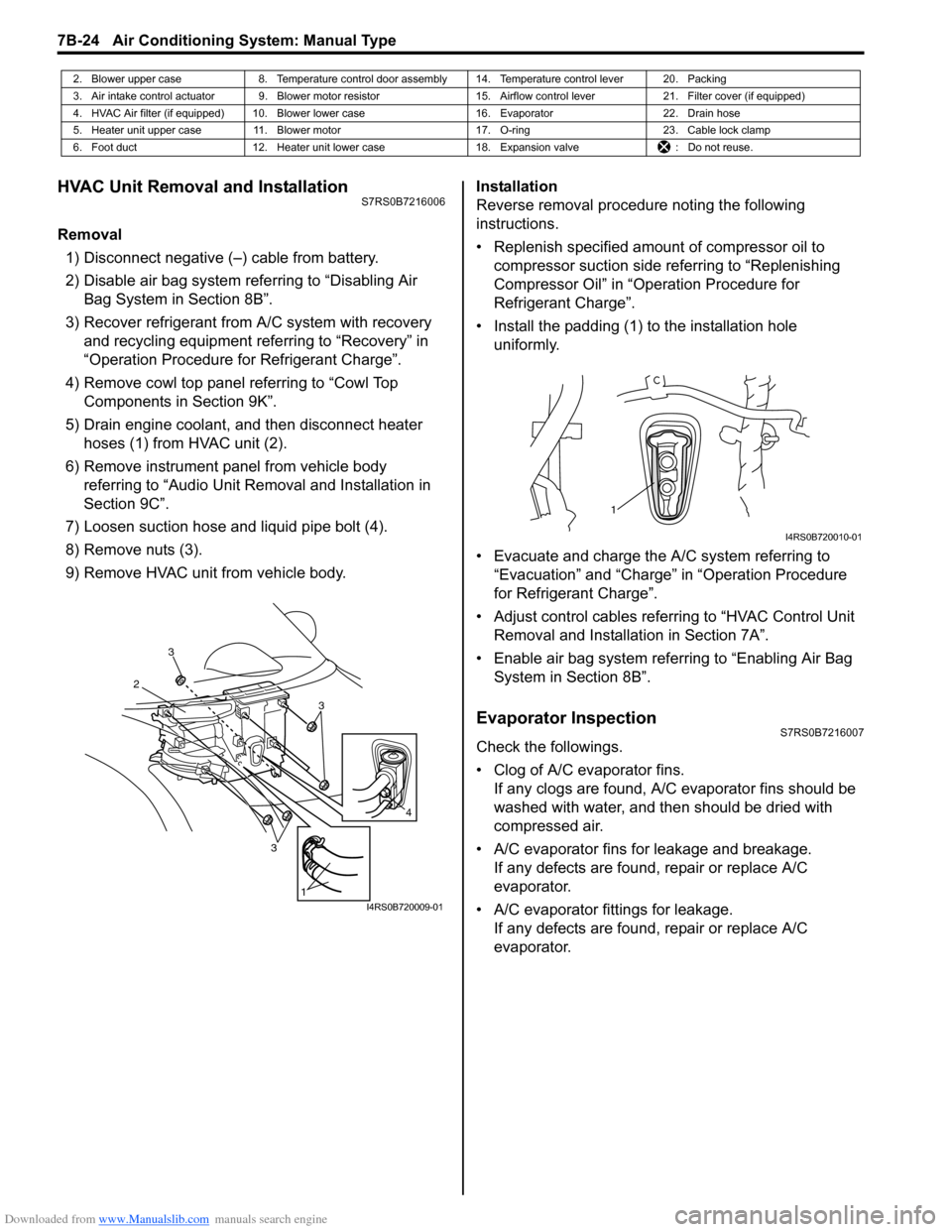
Downloaded from www.Manualslib.com manuals search engine 7B-24 Air Conditioning System: Manual Type
HVAC Unit Removal and InstallationS7RS0B7216006
Removal1) Disconnect negative (тАУ) cable from battery.
2) Disable air bag system referring to тАЬDisabling Air Bag System in Section 8BтАЭ.
3) Recover refrigerant from A/C system with recovery and recycling equipment referring to тАЬRecoveryтАЭ in
тАЬOperation Procedure for Refrigerant ChargeтАЭ.
4) Remove cowl top panel referring to тАЬCowl Top Components in Section 9KтАЭ.
5) Drain engine coolant, and then disconnect heater hoses (1) from HVAC unit (2).
6) Remove instrument panel from vehicle body referring to тАЬAudio Unit Re moval and Installation in
Section 9CтАЭ.
7) Loosen suction hose and liquid pipe bolt (4).
8) Remove nuts (3).
9) Remove HVAC unit from vehicle body. Installation
Reverse removal procedure noting the following
instructions.
тАв Replenish specified amount of compressor oil to
compressor suction side referring to тАЬReplenishing
Compressor OilтАЭ in тАЬOperation Procedure for
Refrigerant ChargeтАЭ.
тАв Install the padding (1) to the installation hole uniformly.
тАв Evacuate and charge the A/C system referring to тАЬEvacuationтАЭ and тАЬChargeтАЭ in тАЬOperation Procedure
for Refrigerant ChargeтАЭ.
тАв Adjust control cables referr ing to тАЬHVAC Control Unit
Removal and Installati on in Section 7AтАЭ.
тАв Enable air bag system referring to тАЬEnabling Air Bag System in Section 8BтАЭ.
Evaporator InspectionS7RS0B7216007
Check the followings.
тАв Clog of A/C evaporator fins.If any clogs are found, A/C evaporator fins should be
washed with water, and then should be dried with
compressed air.
тАв A/C evaporator fins for leakage and breakage. If any defects are found, repair or replace A/C
evaporator.
тАв A/C evaporator fittings for leakage. If any defects are found, repair or replace A/C
evaporator.
2. Blower upper case 8. Temperature control door assembly 14. Temperature control lever 20. Packing
3. Air intake control actuator 9. Blower motor resistor 15. Airflow control lever21. Filter cover (if equipped)
4. HVAC Air filter (if equipped) 10. Blower lower case 16. Evaporator22. Drain hose
5. Heater unit upper case 11. Blower motor 17. O-ring23. Cable lock clamp
6. Foot duct 12. Heater unit lower case 18. Expansion valve: Do not reuse.
3
2
3
3
1
4
I4RS0B720009-01
1
I4RS0B720010-01
Page 974 of 1496
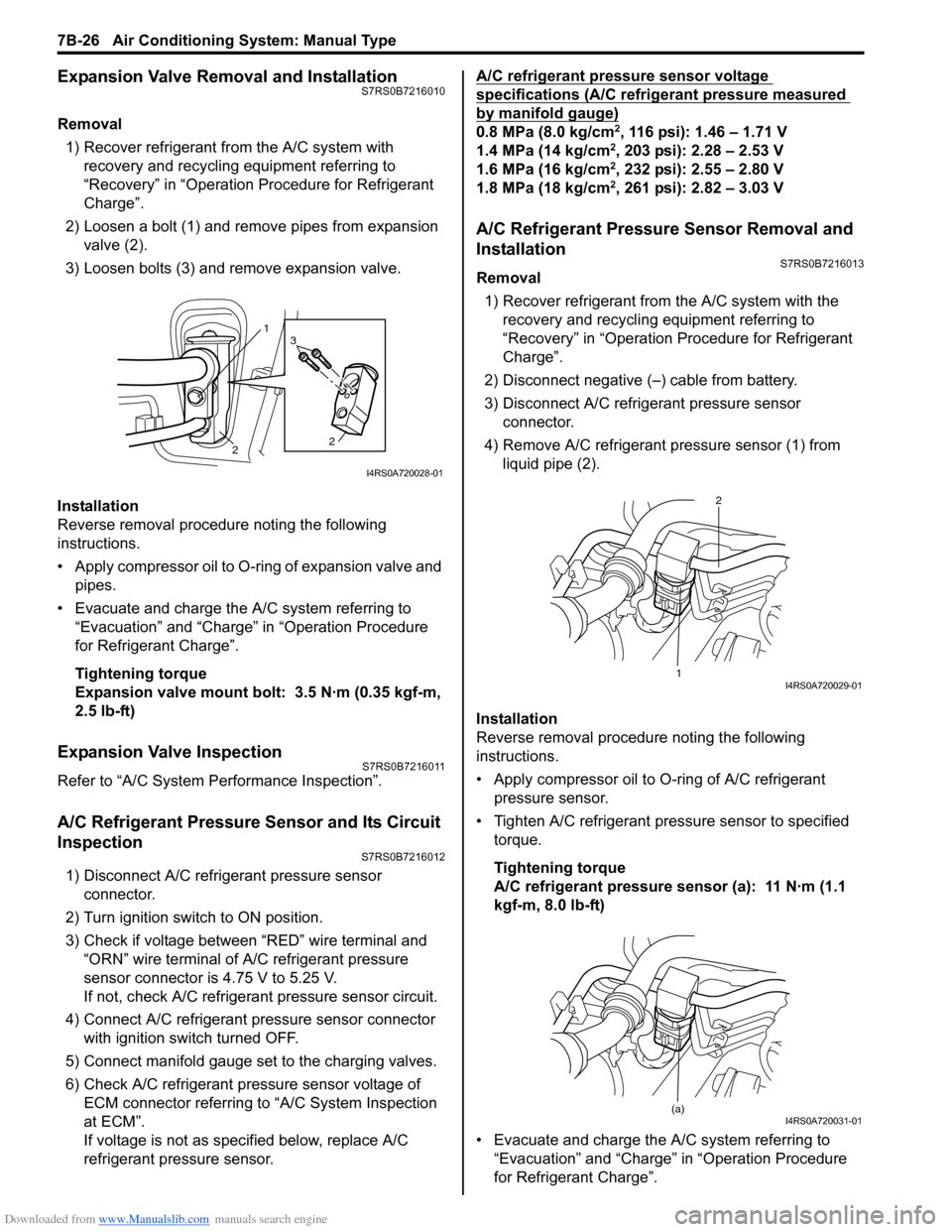
Downloaded from www.Manualslib.com manuals search engine 7B-26 Air Conditioning System: Manual Type
Expansion Valve Removal and InstallationS7RS0B7216010
Removal1) Recover refrigerant fr om the A/C system with
recovery and recycling equipment referring to
тАЬRecoveryтАЭ in тАЬOperation Procedure for Refrigerant
ChargeтАЭ.
2) Loosen a bolt (1) and remove pipes from expansion valve (2).
3) Loosen bolts (3) and remove expansion valve.
Installation
Reverse removal procedure noting the following
instructions.
тАв Apply compressor oil to O-ring of expansion valve and pipes.
тАв Evacuate and charge the A/C system referring to тАЬEvacuationтАЭ and тАЬChargeтАЭ in тАЬOperation Procedure
for Refrigerant ChargeтАЭ.
Tightening torque
Expansion valve mount bolt: 3.5 N┬╖m (0.35 kgf-m,
2.5 lb-ft)
Expansion Valve InspectionS7RS0B7216011
Refer to тАЬA/C System Performance InspectionтАЭ.
A/C Refrigerant Pressure Sensor and Its Circuit
Inspection
S7RS0B7216012
1) Disconnect A/C refrigerant pressure sensor connector.
2) Turn ignition switch to ON position.
3) Check if voltage between тАЬREDтАЭ wire terminal and тАЬORNтАЭ wire terminal of A/C refrigerant pressure
sensor connector is 4.75 V to 5.25 V.
If not, check A/C refrigerant pressure sensor circuit.
4) Connect A/C refrigerant pressure sensor connector with ignition switch turned OFF.
5) Connect manifold gauge set to the charging valves.
6) Check A/C refrigerant pressure sensor voltage of ECM connector referring to тАЬA/C System Inspection
at ECMтАЭ.
If voltage is not as specified below, replace A/C
refrigerant pressure sensor. A/C refrigerant pressure sensor voltage
specifications (A/C refrigerant pressure measured
by manifold gauge)
0.8 MPa (8.0 kg/cm2, 116 psi): 1.46 тАУ 1.71 V
1.4 MPa (14 kg/cm2, 203 psi): 2.28 тАУ 2.53 V
1.6 MPa (16 kg/cm2, 232 psi): 2.55 тАУ 2.80 V
1.8 MPa (18 kg/cm2, 261 psi): 2.82 тАУ 3.03 V
A/C Refrigerant Pressure Sensor Removal and
Installation
S7RS0B7216013
Removal
1) Recover refrigerant from the A/C system with the recovery and recycling equipment referring to
тАЬRecoveryтАЭ in тАЬOperation Procedure for Refrigerant
ChargeтАЭ.
2) Disconnect negative (тАУ) cable from battery.
3) Disconnect A/C refrigerant pressure sensor connector.
4) Remove A/C refrigerant pressure sensor (1) from liquid pipe (2).
Installation
Reverse removal procedure noting the following
instructions.
тАв Apply compressor oil to O-ring of A/C refrigerant
pressure sensor.
тАв Tighten A/C refrigerant pressure sensor to specified torque.
Tightening torque
A/C refrigerant pressure sensor (a): 11 N┬╖m (1.1
kgf-m, 8.0 lb-ft)
тАв Evacuate and charge the A/C system referring to тАЬEvacuationтАЭ and тАЬChargeтАЭ in тАЬOperation Procedure
for Refrigerant ChargeтАЭ.
1
2 2
3
I4RS0A720028-01
1 2I4RS0A720029-01
(a)I4RS0A720031-01
Page 975 of 1496
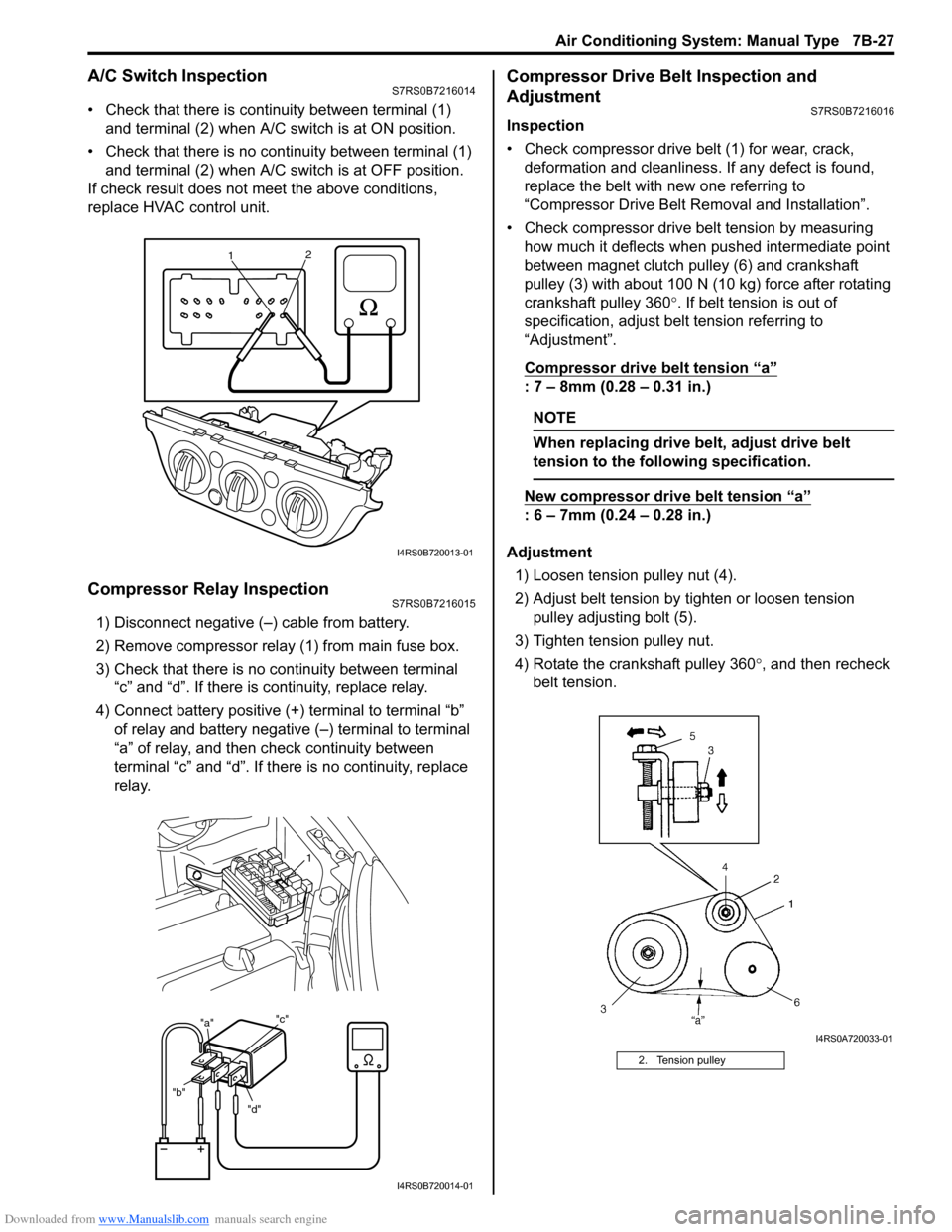
Downloaded from www.Manualslib.com manuals search engine Air Conditioning System: Manual Type 7B-27
A/C Switch InspectionS7RS0B7216014
тАв Check that there is continuity between terminal (1) and terminal (2) when A/C s witch is at ON position.
тАв Check that there is no continuity between terminal (1) and terminal (2) when A/C s witch is at OFF position.
If check result does not meet the above conditions,
replace HVAC control unit.
Compressor Relay InspectionS7RS0B7216015
1) Disconnect negative (тАУ) cable from battery.
2) Remove compressor relay (1) from main fuse box.
3) Check that there is no continuity between terminal тАЬcтАЭ and тАЬdтАЭ. If there is continuity, replace relay.
4) Connect battery positive (+ ) terminal to terminal тАЬbтАЭ
of relay and battery negative (тАУ) terminal to terminal
тАЬaтАЭ of relay, and then check continuity between
terminal тАЬcтАЭ and тАЬdтАЭ. If there is no continuity, replace
relay.
Compressor Drive Belt Inspection and
Adjustment
S7RS0B7216016
Inspection
тАв Check compressor drive belt (1) for wear, crack, deformation and cleanliness. If any defect is found,
replace the belt with new one referring to
тАЬCompressor Drive Belt Re moval and InstallationтАЭ.
тАв Check compressor drive belt tension by measuring how much it deflects when pushed intermediate point
between magnet clutch pulley (6) and crankshaft
pulley (3) with about 100 N (10 kg) force after rotating
crankshaft pulley 360 ┬░. If belt tension is out of
specification, adjust belt tension referring to
тАЬAdjustmentтАЭ.
Compressor drive belt tension
тАЬaтАЭ
: 7 тАУ 8mm (0.28 тАУ 0.31 in.)
NOTE
When replacing drive belt, adjust drive belt
tension to the following specification.
New compressor dr ive belt tension тАЬaтАЭ
: 6 тАУ 7mm (0.24 тАУ 0.28 in.)
Adjustment 1) Loosen tension pulley nut (4).
2) Adjust belt tension by ti ghten or loosen tension
pulley adjusting bolt (5).
3) Tighten tension pulley nut.
4) Rotate the crankshaft pulley 360 ┬░, and then recheck
belt tension.
1 2
I4RS0B720013-01
"d"
"b" "a"
"c"
1
I4RS0B720014-01
2. Tension pulley
I4RS0A720033-01
Page 976 of 1496
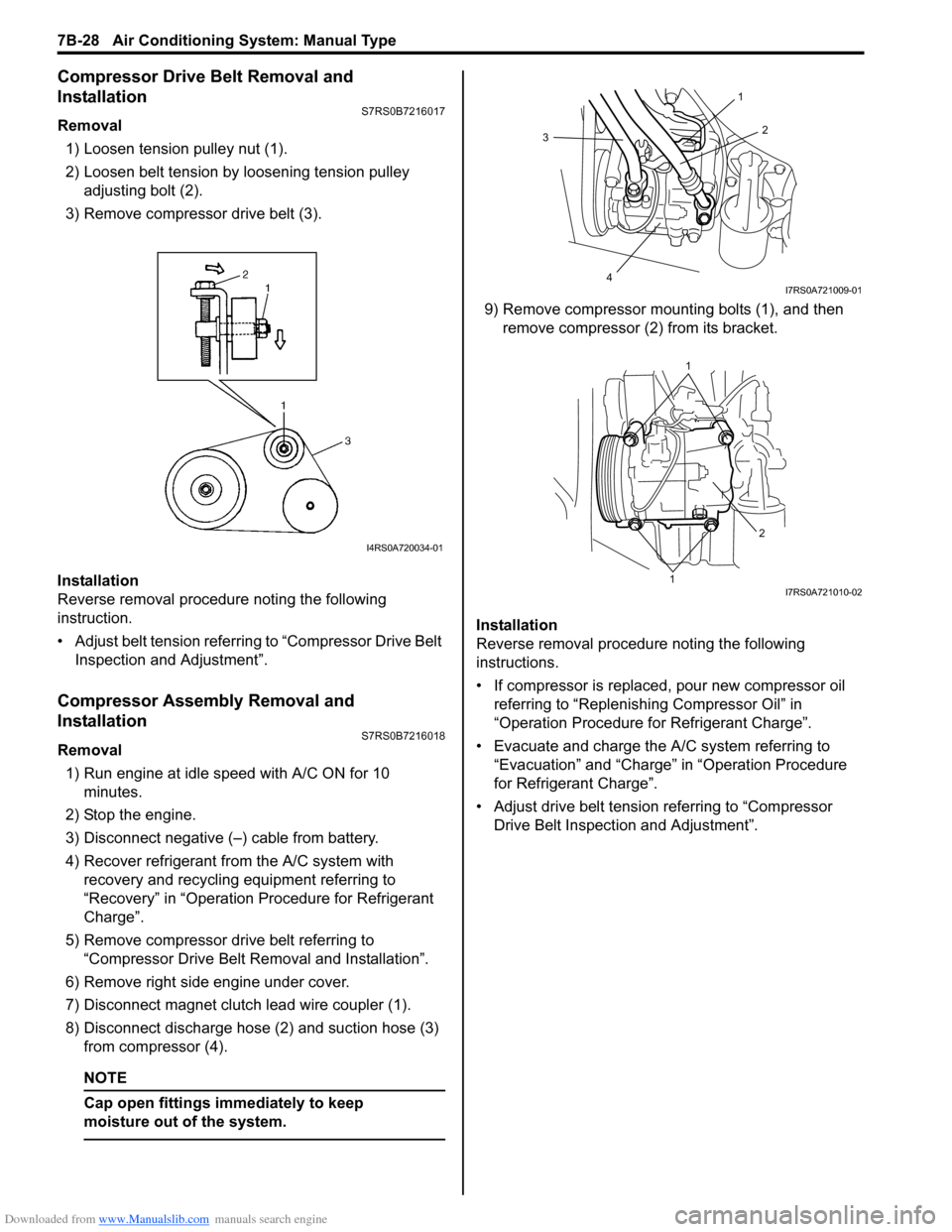
Downloaded from www.Manualslib.com manuals search engine 7B-28 Air Conditioning System: Manual Type
Compressor Drive Belt Removal and
Installation
S7RS0B7216017
Removal1) Loosen tension pulley nut (1).
2) Loosen belt tension by loosening tension pulley adjusting bolt (2).
3) Remove compressor drive belt (3).
Installation
Reverse removal procedure noting the following
instruction.
тАв Adjust belt tension referring to тАЬCompressor Drive Belt Inspection and AdjustmentтАЭ.
Compressor Assembly Removal and
Installation
S7RS0B7216018
Removal
1) Run engine at idle speed with A/C ON for 10 minutes.
2) Stop the engine.
3) Disconnect negative (тАУ) cable from battery.
4) Recover refrigerant fr om the A/C system with
recovery and recycling equipment referring to
тАЬRecoveryтАЭ in тАЬOperation Procedure for Refrigerant
ChargeтАЭ.
5) Remove compressor drive belt referring to тАЬCompressor Drive Belt Re moval and InstallationтАЭ.
6) Remove right side engine under cover.
7) Disconnect magnet clutch lead wire coupler (1).
8) Disconnect discharge hose (2) and suction hose (3) from compressor (4).
NOTE
Cap open fittings immediately to keep
moisture out of the system.
9) Remove compressor mounting bolts (1), and then remove compressor (2 ) from its bracket.
Installation
Reverse removal procedure noting the following
instructions.
тАв If compressor is replaced, pour new compressor oil referring to тАЬReplenishi ng Compressor OilтАЭ in
тАЬOperation Procedure for Refrigerant ChargeтАЭ.
тАв Evacuate and charge the A/C system referring to тАЬEvacuationтАЭ and тАЬChargeтАЭ in тАЬOperation Procedure
for Refrigerant ChargeтАЭ.
тАв Adjust drive belt tension referring to тАЬCompressor Drive Belt Inspecti on and AdjustmentтАЭ.
I4RS0A720034-01
3
4 2
1
I7RS0A721009-01
1
1 2
I7RS0A721010-02
Page 977 of 1496

Downloaded from www.Manualslib.com manuals search engine Air Conditioning System: Manual Type 7B-29
Compressor Assembly ComponentsS7RS0B7216020
Magnet Clutch InspectionS7RS0B7216022
тАв Check armature plate and magnet clutch pulley for wear and oil soak respectively.
тАв Check magnet clutch pulley bearing for noise, wear and grease leakage.
тАв Measure magnet clutch coil for resistance at 20 ┬░C (68
┬░ F). If the measured resistance does out of
specification, replace magnet clutch assembly.
Magnet clutch coil resistance
Standard: 3.5 тАУ 4.0 тДж
Magnet Clutch Removal and InstallationS7RS0B7216024
Removal
1) Remove compressor from vehicle referring to тАЬCompressor Assembly Re moval and InstallationтАЭ.
2) Fix armature plate (1) with special tool and remove armature plate nut (2).
Special tool
(A): 09991тАУ06310
3) Remove armature plate (1).
6
2
9
44
3 (b)
1 (a) 7
5
8
I4RS0A720037-01
1. Armature plate bolt
4. Circlip 7. Magnet clutch pulley: Do not reuse.
2. Compressor 5. Shim 8. Armature plate: 16 NтЛЕm (1.6 kgf-m, 11.5 lb-ft)
3. Relief valve 6. Magnet clutch coil and thermal switch 9. O-ring : 10 NтЛЕm (1.0 kgf-m, 7.5 lb-ft)
I4RS0A720038-01
2
1 (A)
I4RS0A720039-01
Page 978 of 1496
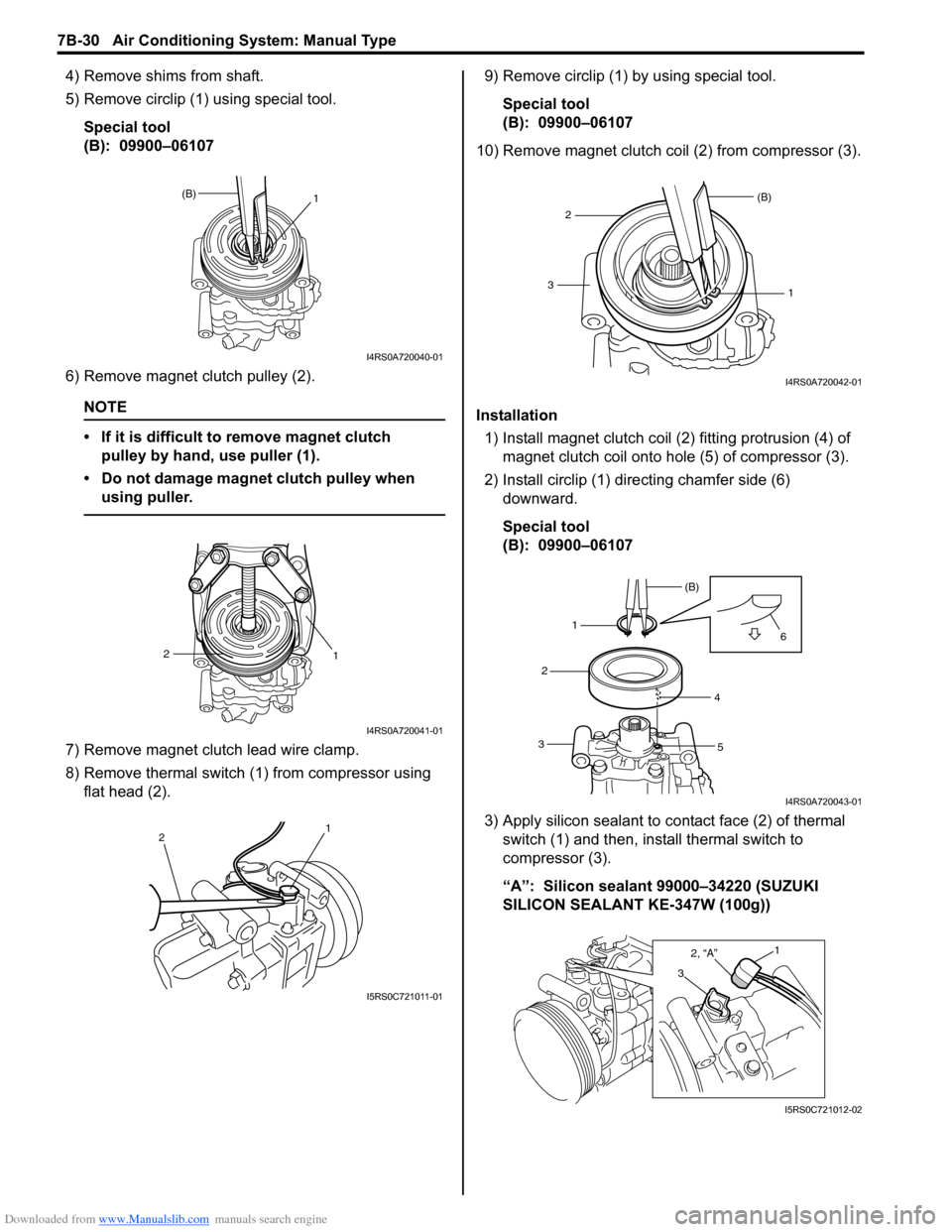
Downloaded from www.Manualslib.com manuals search engine 7B-30 Air Conditioning System: Manual Type
4) Remove shims from shaft.
5) Remove circlip (1) using special tool.Special tool
(B): 09900тАУ06107
6) Remove magnet clutch pulley (2).
NOTE
тАв If it is difficult to remove magnet clutch pulley by hand, use puller (1).
тАв Do not damage magnet clutch pulley when using puller.
7) Remove magnet clutch lead wire clamp.
8) Remove thermal switch (1) from compressor using flat head (2). 9) Remove circlip (1) by using special tool.
Special tool
(B): 09900тАУ06107
10) Remove magnet clutch coil (2) from compressor (3).
Installation 1) Install magnet clutch coil (2) fitting protrusion (4) of magnet clutch coil onto hole (5) of compressor (3).
2) Install circlip (1) dire cting chamfer side (6)
downward.
Special tool
(B): 09900тАУ06107
3) Apply silicon sealant to co ntact face (2) of thermal
switch (1) and then, inst all thermal switch to
compressor (3).
тАЬAтАЭ: Silicon sealant 99000тАУ34220 (SUZUKI
SILICON SEALANT KE-347W (100g))
(B) 1
I4RS0A720040-01
1
2
I4RS0A720041-01
2 1
I5RS0C721011-01
1
(B)
23
I4RS0A720042-01
1 (B)
2
3 4
5 6
I4RS0A720043-01
3
2, тАЬAтАЭ1
I5RS0C721012-02
Page 979 of 1496
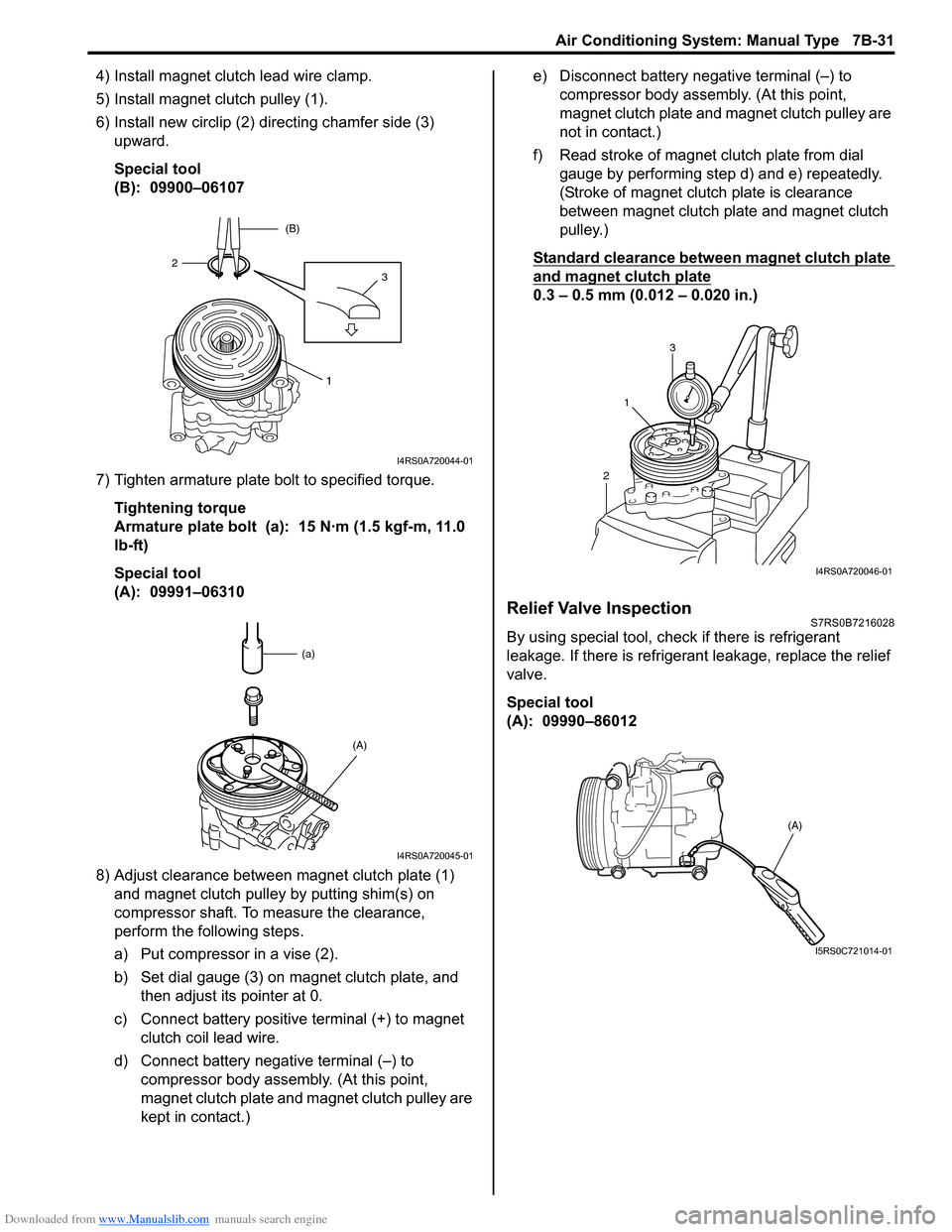
Downloaded from www.Manualslib.com manuals search engine Air Conditioning System: Manual Type 7B-31
4) Install magnet clutch lead wire clamp.
5) Install magnet clutch pulley (1).
6) Install new circlip (2) directing chamfer side (3) upward.
Special tool
(B): 09900тАУ06107
7) Tighten armature plate bolt to specified torque. Tightening torque
Armature plate bolt (a): 15 N┬╖m (1.5 kgf-m, 11.0
lb-ft)
Special tool
(A): 09991тАУ06310
8) Adjust clearance between magnet clutch plate (1) and magnet clutch pulley by putting shim(s) on
compressor shaft. To measure the clearance,
perform the following steps.
a) Put compressor in a vise (2).
b) Set dial gauge (3) on magnet clutch plate, and then adjust its pointer at 0.
c) Connect battery positive terminal (+) to magnet clutch coil lead wire.
d) Connect battery negative terminal (тАУ) to compressor body assemb ly. (At this point,
magnet clutch plate and magnet clutch pulley are
kept in contact.) e) Disconnect battery negative terminal (тАУ) to
compressor body assembly. (At this point,
magnet clutch plate and magnet clutch pulley are
not in contact.)
f) Read stroke of magnet clutch plate from dial gauge by performing step d) and e) repeatedly.
(Stroke of magnet clutch plate is clearance
between magnet clutch plate and magnet clutch
pulley.)
Standard clearance between magnet clutch plate
and magnet clutch plate
0.3 тАУ 0.5 mm (0.012 тАУ 0.020 in.)
Relief Valve InspectionS7RS0B7216028
By using special tool, chec k if there is refrigerant
leakage. If there is refrigerant leakage, replace the relief
valve.
Special tool
(A): 09990тАУ86012
1
32 (B)
I4RS0A720044-01
(a)
(A)
I4RS0A720045-01
21
3
I4RS0A720046-01
(A)
I5RS0C721014-01
Page 980 of 1496
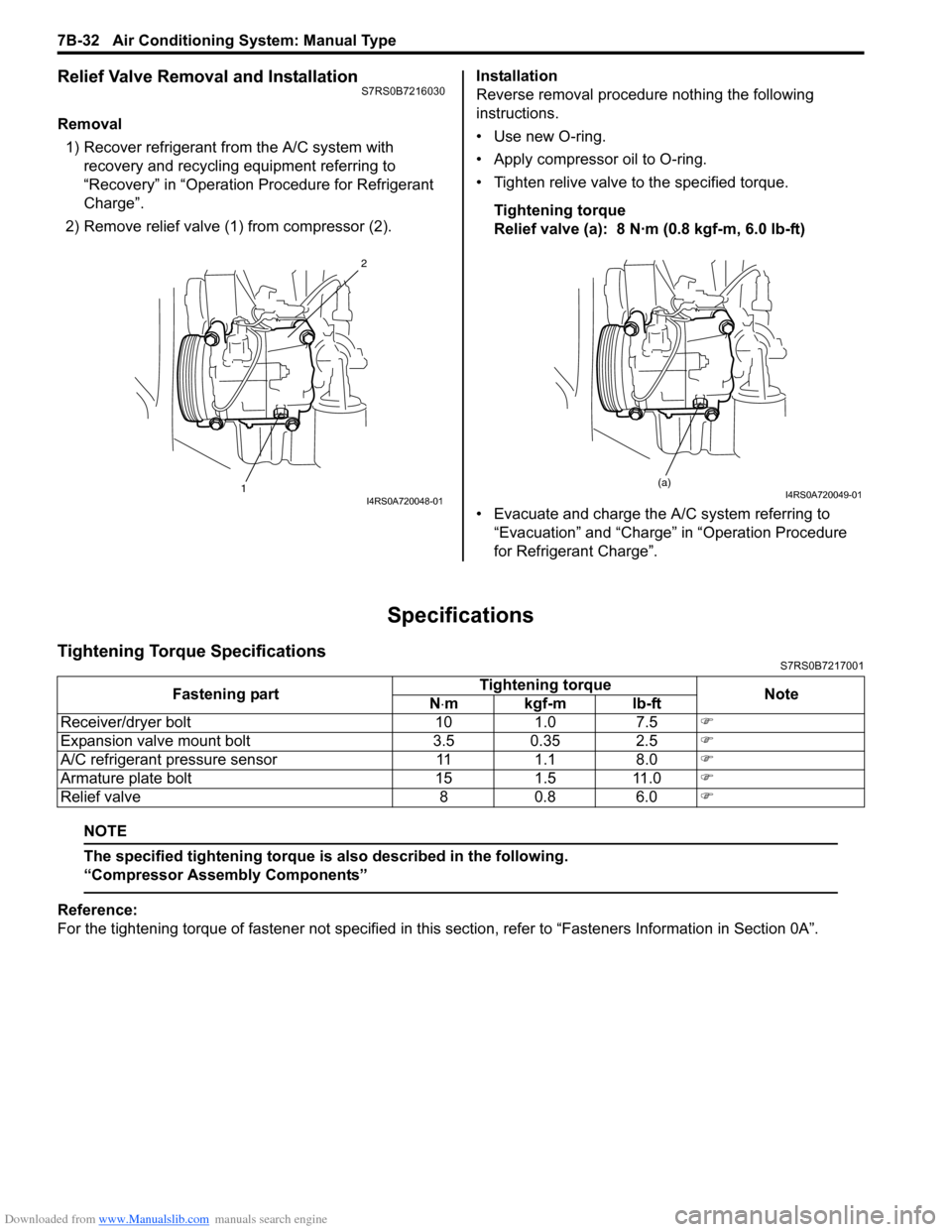
Downloaded from www.Manualslib.com manuals search engine 7B-32 Air Conditioning System: Manual Type
Relief Valve Removal and InstallationS7RS0B7216030
Removal1) Recover refrigerant fr om the A/C system with
recovery and recycling equipment referring to
тАЬRecoveryтАЭ in тАЬOperation Procedure for Refrigerant
ChargeтАЭ.
2) Remove relief valve (1) from compressor (2). Installation
Reverse removal procedure nothing the following
instructions.
тАв Use new O-ring.
тАв Apply compressor oil to O-ring.
тАв Tighten relive valve to the specified torque.
Tightening torque
Relief valve (a): 8 N┬╖m (0.8 kgf-m, 6.0 lb-ft)
тАв Evacuate and charge the A/C system referring to тАЬEvacuationтАЭ and тАЬChargeтАЭ in тАЬOperation Procedure
for Refrigerant ChargeтАЭ.
Specifications
Tightening Torque SpecificationsS7RS0B7217001
NOTE
The specified tightening torque is also described in the following.
тАЬCompressor Assembly ComponentsтАЭ
Reference:
For the tightening torque of fastener not specified in this section, refer to тАЬFasteners Information in Section 0AтАЭ.
12I4RS0A720048-01
(a)I4RS0A720049-01
Fastening part
Tightening torque
Note
N тЛЕmkgf-mlb-ft
Receiver/dryer bolt 10 1.0 7.5 �)
Expansion valve mount bolt 3.5 0.35 2.5 �)
A/C refrigerant pressure sensor 11 1.1 8.0 �)
Armature plate bolt 15 1.5 11.0 �)
Relief valve 8 0.8 6.0 �)